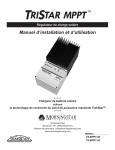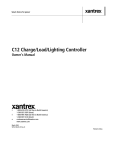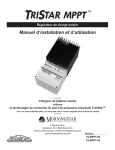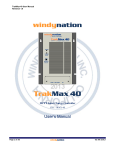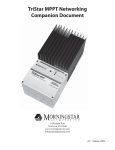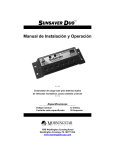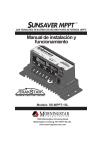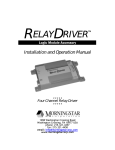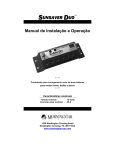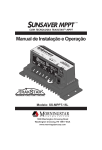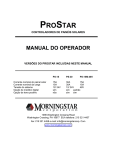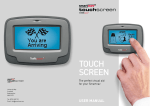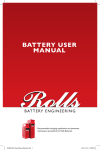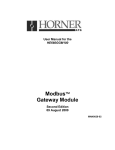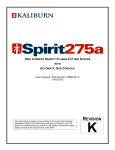Download User Manual - PVPower.com
Transcript
TRISTAR MPPT TM Solar System Controller Installation and Operation Manual Solar Battery Charger with TrakStar TM Maximum Power Point Tracking Technology 8 Pheasant Run Newtown, PA 18940 USA email: [email protected] www.morningstarcorp.com Models MAXIMUM POWER POINT TRACKING TS-MPPT-60 TS-MPPT-45 Dimensions in Inches [Millimeters] Contents 1.0 Important Safety Information 2.0 Getting Started 2.1 Overview 2.2 Versions and Ratings 2.3 Features 2.4 Regulatory Information 2.5 Optional Accessories 3.0 Installation 3.1 General Information 3.2 Controller Installation 4.0 Operation 4.1 TrakStarTM MPPT Technology 4.2 Battery Charging Information 4.3 Push button 4.4 LED Indications 4.5 Protections, Faults & Alarms 4.6 Inspection and Maintenance 5.0 Networking and Communication 5.1 Introduction 5.2 Morningstar MeterBusTM 5.3 Serial RS-232 5.4 EIA-485 (formerly RS-485) 5.5 Ethernet 6.0 Troubleshooting 7.0 Warranty 8.0 Specifications 4 6 6 6 7 9 10 11 11 12 24 24 26 33 34 36 38 39 39 40 41 43 44 47 49 50 1.0 Important Safety Information Save These Instructions This manual contains important safety, installation and operating instructions for the TriStar MPPT solar controller. The following symbols are used throughout this manual to indicate potentially dangerous conditions or mark important safety instructions: WARNING: Indicates a potentially dangerous condition. Use extreme caution when performing this task. ! CAUTION: Indicates a critical procedure for safe and proper operation of the controller. NOTE: Indicates a procedure or function that is important for the safe and proper operation of the controller. Safety Information • Read all of the instructions and cautions in the manual before beginning installation. • There are no user serviceable parts inside the TriStar MPPT. Do not disassemble or attempt to repair the controller. • Disconnect all sources of power to the controller before installing or adjusting the TriStar MPPT. • There are no fuses or disconnects inside the TriStar MPPT. Do not attempt to repair. • Install external fuses/breakers as required. 4 Important Safety Information Installation Safety Precautions WARNING: This unit is not provided with a GFDI device. This charge controller must be used with an external GFDI device as required by the Article 690 of the National Electrical Code for the installation location. • Mount the TriStar MPPT indoors. Prevent exposure to the elements and do not allow water to enter the controller. • Install the TriStar MPPT in a location that prevents casual contact. The TriStar MPPT heatsink can become very hot during operation. • Use insulated tools when working with batteries. • Avoid wearing jewelry during installation. • The battery bank must be comprised of batteries of same type, make, and age. • Do not smoke in the vicinity of the battery bank. • Power connections must remain tight to avoid excessive heating from a loose connection. • Use properly sized conductors and circuit interrupters. • The grounding terminal is located in the wiring compartment and is identified by the symbol below. Ground Symbol • This charge controller is to be connected to DC circuits only. These DC connections are identified by the symbol below. Direct Current Symbol About this Manual This manual provides detailed installation and usage instructions for the TriStar MPPT controller. Only qualified electricians and technicians who are familiar with solar system design and wiring practices should install the TriStar MPPT. The usage information in this manual is intended for the system owner/operator. TriStar MPPT Operator’s Manual 5 2.0 Getting Started 2.1 Overview Thank you for selecting the TriStar MPPT solar charge controller with TrakStarTM MPPT Technology. The TriStar MPPT (TS-MPPT) is an advanced maximum power point tracking solar battery charger. The controller features a smart tracking algorithm that finds and maintains operation at the solar array peak power point, maximizing energy harvest. The TriStar MPPT battery charging process has been optimized for long battery life and improved system performance. Self-diagnostics and electronic error protections prevent damage when installation mistakes or system faults occur. The controller also features eight (8) adjustable settings switches, several communication ports, and terminals for remote battery temperature and voltage measurement. Please take the time to read this operator’s manual and become familiar with the controller. This will help you make full use of the many advantages the TriStar MPPT can provide for your PV system. 2.2 Versions and Ratings There are two versions of TriStar MPPT controllers. TriStar-MPPT-45 • maximum 45 amps continuous battery current • 12, 24, 36, and 48 Volt dc systems • maximum 150 Volt dc solar input voltage • RS-232 and MeterBusTM communication ports TriStar-MPPT-60 • maximum 60 amps continuous battery current • 12, 24, 36, and 48 Volt dc systems • maximum 150 Volt dc solar input voltage • RS-232, EIA-485, MeterBusTM, and Ethernet communication ports To comply with the National Electric Code (NEC), the current rating of the controller must be equal to or greater than 125% of the solar array’s short circuit current output (Isc). Therefore, the maximum allowable solar array input to the TriStar MPPT controller for compliance with the NEC is: TS-MPPT-45: 36 amps Isc* TS-MPPT-60: 48 amps Isc* *Solar array Isc @ STC TriStar MPPT Operator’s Manual 6 2.3 Features The features of the TriStar MPPT are shown in Figure 2-1 below. An explanation of each feature is provided. Figure 2-1. TriStar MPPT features TriStar MPPT Operator’s Manual 7 1 - Heatsink Aluminum heatsink to dissipate controller heat 2 - Mounting Hanger Keyhole slot for mounting 3 - Settings Switches Eight (8) settings switches to configure operation of the TriStar MPPT 4 - Battery Positive Terminal (red) Power connection for Battery (+) 5 - Remote Temperature Sensor Terminals Connection point for a Morningstar RTS (optional) to remotely monitor battery temperature 6 - LED Indicators Three state of charge (SOC) LED indicators show charging status and controller faults 7 - MeterBusTM Port RJ-11 socket for Morningstar MeterBusTM network connections 8 - Battery Voltage Sense Terminals Terminals for battery voltage input provide accurate battery voltage measurement 9 - Ground Terminal A chassis ground terminal for system grounding 10 - Ethernet Port RJ-45 socket for LAN/internet connections (TS-MPPT-60 model only) 11 - Wiring Box with Conduit Knockouts Termination points for wiring conduit and wire glands 12 - Wiring Box Cover Sheet metal wiring box cover protects power connections 13 - Serial RS-232 Port 9-pin serial connector (female) 14 - EIA-485 Port Four (4) position screw terminal for EIA-485 bus connections (TS-MPPT-60 model only) 15 - Solar Positive Terminal (yellow) Power connection for Solar (+) 16 - Common Negative Power Terminals Two (2) negative terminals for negative system cable termination 17 - Push-button Switch Manually reset from an error or fault, also used to start/stop a manual equalization. 8 Getting Started 2.4 Regulatory Information NOTE: This section contains important information for safety and regulatory requirements. The TriStar MPPT controller should be installed by a qualified technician according to the electrical rules of the country in which the product will be installed. TriStar MPPT controllers comply with the following EMC standards: • Immunity: EN61000-6-2:1999 • Emissions: EN55022:1994 with A1 and A3 Class B1 • Safety: EN60335-1 and EN60335-2-29 (battery chargers) A means shall be provided to ensure all pole disconnection from the power supply. This disconnection shall be incorporated in the fixed wiring. Using the TriStar MPPT grounding terminal (in the wiring compartment), a permanent and reliable means for grounding shall be provided. The clamping of the earthing shall be secured against accidental loosening. The entry openings to the TriStar MPPT wiring compartment shall be protected with conduit or with a bushing. FCC requirements: This device complies with Part 15 of the FCC rules. Operation is subject to the following two conditions: (1) This device may not cause harmful interference, and (2) this device must accept any interference received, including interference that may cause undesired operation. Changes or modifications not expressly approved by Morningstar for compliance could void the user’s authority to operate the equipment. Note: This equipment has been tested and found to comply with the limits for a Class B digital device, pursuant to Part 15 of the FCC rules. These limits are designed to provide reasonable protection against harmful interference in a residential installation. This equipment generates, uses, and can radiate radio frequency energy and, if not installed and used in accordance with the instruction manual, may cause harmful interference to radio communication. However, there is no guarantee that interference will not occur in a particular installation. If this equipment does cause harmful interference to radio or television reception, which can be determined by turning the equipment on and off, the user is encouraged to try to correct the interference by one or more of the following measures: • Reorient or relocate the receiving antenna. • Increase the separation between the equipment and receiver. • Connect the equipment into an outlet on a circuit different from that to which the receiver is connected. • Consult the dealer or an experienced radio/TV technician for help. This Class B digital apparatus complies with Canadian ICES-003. Cet appareil numerique de la classe B est conforme a la norme NMB-003 du Canada. TriStar MPPT Operator’s Manual 9 2.5 Optional Accessories The following accessories are available for purchase separately from your authorized Morningstar dealer. TriStar Digital Meter 2 / TriStar Remote Meter 2 (Models: TS-M-2 / TS-RM-2) The TriStar Digital Meter mounts directly on the TS-MPPT controller, replacing the wiring box cover. The TriStar Remote Meter can be flush mounted in a wall or into a standard duplex (2gang) electrical box. A 2 x 16 character display shows system operating information, error indications, and self-diagnostic information. Four (4) buttons make navigating the meter menus easy. For systems where multiple TS-MPPT controllers are networked together, one (1) meter can display full system information. The TriStar meters connect to the RJ- 11 MeterBusTM port on the TriStar-MPPT. Meter Hub (HUB-1) A Morningstar MeterBusTM network with multiple controllers requires a Meter Hub for electrical isolation. The HUB-1 allows communication between MeterBusTM compatible Morningstar products, including the TriStar MPPT controller. DIN rail compatible. See section 5.2 for more details. Relay Driver (RD-1) The Relay DriverTM accessory enables the TriStar MPPT to control external devices. Four (4) relay control ports can be configured (in various combinations) to perform the following tasks: • • • • • generator control (2-, 3-, and 4-wire configurations) dry contacts for alarms and other signals advanced load control vent fan control DIN rail compatible or surface mount For more information on the Relay Driver, visit our website at www.morningstarcorp.com or inquire with your local Morningstar dealer. EIA-485 / RS-232 Communications Adapter (RSC-1) Connect one or more TriStar MPPT controllers to a PC or to other serial devices using the RSC-1 EIA-485 adapter. The adapter converts an RS-232 serial interface to EIA-485 compliant signals. An LED shows network activity and errors. DIN rail compatible. 10 Getting Started 3.0 Installation 3.1 General Information The mounting location is important to the performance and operating life of the controller. The environment must be dry and protected from water ingress. If required, the controller may be installed in a ventilated enclosure with sufficient air flow. Never install the TriStar MPPT in a sealed enclosure. The controller may be mounted in an enclosure with sealed batteries, but never with vented/flooded batteries. Battery fumes from vented batteries will corrode and destroy the TriStar MPPT circuits. Multiple TriStars can be installed in parallel on the same battery bank to achieve higher charging current. Additional parallel controllers can also be added in the future. Each TriStar MPPT must have its own solar array. ! CAUTION: Equipment Damage or Risk of Explosion Never install the TriStar MPPT in an enclosure with vented/flooded batteries. Battery fumes are flammable and will corrode and destroy the TriStar MPPT circuits. ! CAUTION: Equipment Damage When installing the TriStar MPPT in an enclosure, ensure sufficient ventilation. Installation in a sealed enclosure will lead to over-heating and a decreased product lifetime. The installation is straightforward, but it is important each step is done correctly and safely. A mistake can lead to dangerous voltage and current levels. Be sure to carefully follow each instruction in this section. Read all instructions first before beginning installation. The installation instructions are for installation of a negative grounded system. National Electrical Code (NEC) requirements are noted on occasion for convenience, however the installer should have a complete understanding of NEC and UL requirements for photovoltaic installations. Recommended Tools: • Wire strippers • Wire cutters • #2 & #0 Phillips screwdriver • slotted screwdrivers • Pliers • Drill • 3/32” (2.5 mm) drill bit • Level • hack saw (cutting conduit) 11 Installation 3.2 Controller Installation Step 1 - Remove the wiring box cover ! CAUTION: Shock Hazard Disconnect all power sources to the controller before removing the wiring box cover. Never remove the cover when voltage exists on any of the TriStar MPPT power connections. Use a #2 Phillips screw driver to remove the four (4) screws that secure the wiring box cover as shown in figure 3-1 below. Figure 3-1. Remove the wiring box cover. If a TriStar Digital Meter display is installed, be sure to disconnect the RJ-11 cable. Step 2 - Remove the knockouts Knockouts are provided for routing cables through conduit or wire glands. Table 3-1 below provides the knockout sizes and quantity on the TriStar MPPT wiring box. Knockout locations and dimensions are on the inside front cover. Quantity Trade Size Hole Dimension 8 1/2” or M20 7/8” (22.2 mm) 6 1“ 1 - 23/64 “ (34.5 mm) 4 1 - 1/4 “ 1 - 23/32 “ (43.7 mm) Table 3-1. Knockout sizes ! CAUTION: Shock Hazard Always use bushings, connectors, clamp connectors, or wire glands in the knockout openings to protect wiring from sharp edges. ! CAUTION: Shock Hazard Never route network cables in the same conduit as the power conductors. Plan the routing of each conductor that will connect to the TriStar MPPT before removing any knockouts. The 1/2” (M20) knockouts are ideal for routing network cables, which must be placed in separate conduit. 12 Installation Step 3 - Mount to a Vertical Surface ! CAUTION: Risk of Burns Install the TriStar MPPT in a location that prevents casual contact. The TriStar MPPT heatsink can become very hot during operation. Figure 3-2. Attaching the mounting hanger 1. Attach the mounting hanger to the bottom of the TriStar MPPT with the M6 screw provided as shown in figure 3-2. 2. Place the TriStar MPPT on a vertical surface protected from direct sun, high temperatures, and water. The TriStar MPPT requires at least 6” (150 mm) of clearance above and below and at least 1” (25 mm) on each side for proper air flow as shown in figure 3-3 below. Figure 3-3. Required mounting clearance for air flow. TriStar MPPT Operator’s Manual 13 3. Place a mark on the mounting surface at the top of the keyhole. 4. Remove the controller and drill a 3/32” (2.5 mm) hole at the drill mark. 5. Insert a #10 screw (included) into the top pilot hole. Do not tighten the screw completely. Leave a 1/4” (6 mm) gap between the mounting surface and screw head. 6. Carefully align the keyhole on the TriStar MPPT with the screw head. Slide the TriStar MPPT down over the keyhole. 7. Check for vertical plumb with a level. 8. Mark two (2) mounting hole locations in the wiring box. 9. Remove the controller and drill 3/32” (2.5 mm) holes at the drill marks. 10. Carefully align the keyhole on the TriStar MPPT with the screw head. Slide the TriStar MPPT down over the keyhole. 11. The pre-drilled pilot holes should align with the mounting holes in the wiring box. Secure the controller with two (2) #10 mounting screws. 12. Tighten the keyhole screw. Step 4 - Adjust Settings Switches Switch 1: Reserved for Future Use Settings switch 1 should remain in the “OFF” position. Mode Switch 1 Solar Charging OFF future use ON Switches 2 & 3: System Voltage Four (4) system voltage configurations are available as shown in the table below: System Voltage Switch 2 Switch 3 Auto OFF OFF 12 OFF ON 24 ON OFF 48 ON ON The “auto” setting allows the TriStar MPPT to detect the system voltage automatically on start up. The test is only performed at start up and the detected system voltage will never change during operation. Generally, it is best to choose a specific system voltage. The auto detect feature should only be used in situations where the system voltage is unknown ahead of time or in systems where the system voltage may change periodically. 14 Installation Switches 4, 5, & 6: Battery Charging Settings It is important to select the battery type that matches the system battery to ensure proper charging and long battery life. Refer to the specifications provided by the battery manufacturer and choose a setting that best fits the recommended charging profile. Settings Switches 4-5-6 Battery Type Absorp. Stage (Volts) Float Stage (Volts) Equalize Stage (Volts) Equalize Interval (Days) off-off-off 1 - Gel 14.00 13.70 off-off-on 2 - Sealed* 14.15 13.70 14.40 28 off-on-off 3 - Sealed* 14.30 13.70 14.60 28 off-on-on 4 - AGM/Flooded 14.40 13.70 15.10 28 on-off-off 5 - Flooded 14.60 13.50 15.30 28 on-off-on 6 - Flooded 14.70 13.50 15.40 28 on-on-off 7 - L-16 15.40 13.40 16.00 14 on-on-on 8 - Custom Custom Custom Custom Custom * “Sealed” battery type includes gel and AGM batteries All settings are for 12 Volt nominal systems. Multiply the charge voltage settings by 2 for 24 Volt systems or by 4 for 48 Volt systems. A description of each setting is provided below. See section 4.3 for full details on battery charging and a description of each of the settings in the battery charging table. Battery Type - The most common battery type associated with the specified charging settings. Absorption Stage - This stage limits input current so that the Absorption voltage is maintained. As the battery becomes more charged, the charging current continues to taper down until the battery is fully charged. Float Stage - When the battery is fully charged, the charging voltage will be reduced to the Float voltage setting. Equalize Stage - During an equalization cycle, the charging voltage will be held constant at the specified voltage setting. Equalize Interval - The number of days between equalization charges when the controller is configured for automatic equalizations (settings switch 7). Switch 7: Battery Equalization Choose between manual and automatic battery equalization charging. In the manual equalization setting, an equalization will only occur when manually started with the pushbutton or when requested from the equalize menu on the TriStar meter. Automatic equalization will occur according to the battery program specified by settings switches 4, 5, & 6 in the previous step. In both settings (auto and manual), the pushbutton can be used to start and stop battery equalization. If the selected battery charging setting does not have an equalization stage an equalization will never occur, even if requested manually. TriStar MPPT Operator’s Manual 15 Equalize Switch 7 manual OFF automatic ON Switch 8: Ethernet Security The Ethernet Security switch enables or disables configuration of the TriStar MPPT settings through the Ethernet connection. When switch eight is set to disabled, write commands to the TriStar MPPT custom memory are not allowed. This a safety feature to prevent unintended changes to custom settings, but it is not a replacement for proper network security. Configuration via TCP/IP Switch 8 disabled OFF enabled ON NOTE: Adjustment of network settings and custom setpoints is always enabled via the RS-232 and EIA485 connections. The Ethernet Security switch only enables/disables remote configuration via TCP/IP. ! CAUTION: Risk of Tampering The Ethernet Security settings switch does not block write commands to devices bridged via EIA485. Step 5 - Remote Temperature Sensor The included Remote Temperature Sensor (RTS) is recommended for effective temperature compensated charging. Connect the RTS to the 2-position terminal located between the pushbutton and the LED’s (see figure 2-1). The RTS is supplied with 33 ft (10 m) of 22 AWG (0.34 mm2) cable. There is no polarity, so either wire (+ or -) can be connected to either screw terminal. The RTS cable may be pulled through conduit along with the power wires. Tighten the connector screws to 5 in-lb (0.56 Nm) of torque. Separate installation instructions are provided inside the RTS bag. ! CAUTION: The TriStar MPPT will not temperature compensate charging parameters if the RTS is not used. ! CAUTION: Equipment Damage Never place the temperature sensor inside a battery cell. Both the RTS and the battery will be damaged. NOTE: The RTS cable may be shortened if the full length is not needed. Be sure to reinstall the ferrite choke on the end of the RTS if a length of cable is removed. This choke ensures compliance with electromagnetic emissions standards. 16 Installation Step 6 - Grounding and Ground Fault Interruption WARNING: This unit is not provided with a GFDI device. This charge controller must be used with an external GFDI device as required by the Article 690 of the National Electrical Code for the installation location. Use a copper wire to connect the grounding terminal in the wiring box to earth ground. The grounding terminal is identified by the ground symbol shown below that is stamped into the wiring box just below the terminal: Figure 3-4. Ground Symbol Do not connect the system negative conductor to this terminal. NEC requires the use of an external ground fault protection device (GFPD). The TriStar MPPT does not have internal ground fault protection. The system electrical negative should be bonded through a GFPD to earth ground at one (and only one) location. The grounding point may be located in the solar circuit or the battery circuit. The minimum size of the copper grounding wire: • TS-MPPT-45-150V 10 AWG (6 mm2) • TS-MPPT-60-150V 8 AWG (10 mm2) WARNING: Risk of Fire DO NOT bond system electrical negative to earth ground at the controller. Per NEC requirements, system negative must be bonded to earth ground through a GFPD at only one point. Step 7 - Battery Voltage Sense The voltage at the battery connection on the TriStar MPPT may differ slightly from the voltage directly at the battery bank terminals due to connection and cable resistance. The Battery Voltage Sense connection enables the TriStar MPPT to measure the battery terminal voltage precisely with small gauge wires that carry very little current, and thus have no voltage drop. Both battery voltage sense wires are connected to the TriStar at the 2-position terminal located between the pushbutton and the positive (+) terminal lug (see figure 2-1). A battery voltage sense connection is not required to operate your TriStar MPPT controller, but it is recommended for best performance. If a TriStar meter will be added to the controller, the battery voltage sense will ensure that the voltage and diagnostic displays are very accurate. The voltage sense wires should be cut to length as required to connect the battery to the voltage TriStar MPPT Operator’s Manual 17 sense terminal. The wire size can range from 16 to 24 AWG (1.0 to 0.25 mm2). A twisted pair cable is recommended but not required. Use UL rated 300 Volt conductors. The voltage sense wires may be pulled through conduit with the power conductors. Tighten the connector screws to 5 in-lb (0.56 Nm) of torque. The maximum length allowed for each battery voltage sense wire is 98 ft (30 m). Be careful to connect the battery positive (+) terminal to the voltage sense positive (+) terminal. No damage will occur if the polarity is reversed, but the controller cannot read a reversed sense voltage. Connecting the voltage sense wires to the RTS terminal will cause an alarm. If a TriStar meter is installed, check the “TriStar Settings” to confirm the Voltage Sense and the RTS (if installed) are both present and detected by the controller. MSViewTM PC software can also be used to confirm the voltage sense is working correctly. Step 9 - Network Connections Network connections allow the TriStar MPPT to communicate with other controller or computers. A network can be as simple as one controller and one PC, or as complex as dozens of controllers monitored via the internet. Review section 5.0 for more information about networking and the connection(s) required for your system. WARNING: Shock Hazard Never route network cables in the same conduit as the power conductors. WARNING: Shock Hazard Only use 300 Volt UL rated communication cable. Connect the appropriate network cables to the TriStar MPPT at this time. Access to the network ports is easier before the power cables are attached. The ports are located inside the conduit wiring box on the lower circuit board as shown in figure 3-5. 18 Installation Figure 3-5. TriStar MPPT network port locations EIA-485 Connection The four (4) position EIA-485 connector on the TriStar MPPT must be removed to access the terminal screws. Remove the socket connector by firmly grasping the connector body and pulling away from the circuit board as shown in figure 3-6. Figure 3-6. Removing the RS-485 socket connector RS-232 Connection The serial RS-232 port is a standard 9-pin (DB9) female connector. A low-profile serial connector TriStar MPPT Operator’s Manual 19 is recommended to save room in the wiring box. NOTE: The RS-232 and EIA-485 ports share hardware. Both ports cannot be used simultaneously. Ethernet Connection The RJ-45 Ethernet jack features two (2) indicator LEDs for connection status and network traffic. Use CAT-5 or CAT-5e twisted pair cable and RJ-45 plugs. If possible, pull the network cable through conduit before crimping on the RJ-45 connectors. If using pre-assembled cables, take care not to damage the plugs when the cables are pulled through conduit. MeterBusTM Connection MeterBusTM networks use standard 4-wire or 6-wire RJ-11 telephone cables. If possible, pull the telephone cable through conduit before crimping on the RJ-11 connectors. If using pre-assembled cables, take care not to damage the plugs when the cables are pulled through conduit. 20 Installation Step 9 - Power Connections NOTE: To comply with the NEC, the TriStar MPPT must be installed using wiring methods in accordance with the latest edition of the National Electric Code, NFPA 70. ! CAUTION: Risk of Fire and Shock Connect battery terminals prior to the connection of array terminals. The battery positive (+) terminal has a red cover, the solar positive (+) terminal has a yellow cover. Wire Size The four large power terminals are sized for 14 - 2 AWG (2.5 - 35 mm2) wire. The terminals are rated for copper and aluminum conductors. Use UL-listed Class B 300 Volt stranded wire only. Good system design requires large conductor wires for the solar and battery connections that limit voltage drop losses to 2% or less. The wire tables on pages 56-59 provide wire sizing information for connecting the solar array and battery bank to the TriStar MPPT with a maximum of 2% voltage drop. Minimum Wire Size WARNING: Risk of Fire Failure to use properly sized power conductors may result in excessive wire heating, equipment damage, and fire. Use the wire charts in the back of this manual to properly size conductors for the wire length, wire type, and maximum ambient temperature. The NEC requires that the wires carrying the system current never exceed 80% of the conductors current rating. The table below provides the minimum size of copper wire allowed by NEC for both TriStar MPPT models when the current equals the full nameplate rating (45 Amps or 60 Amps). Wire types rated for 75°C and 90°C are included. Minimum wire sizes for ambient temperatures to 45°C are provided in table 3-2 below. Larger gauge wire may be required depending on the length of the cables in the system. Refer to the wire sizing charts in the back of this manual. Model Wire Type 75°C Wire TS-MPPT-45-150V Copper 6 AWG (16 mm ) 8 AWG (10 mm2) TS-MPPT-45-150V Aluminum 4 AWG (25 mm2) 6 AWG (16 mm2) TS-MPPT-60-150V Copper 4 AWG (25 mm2) 6 AWG (16 mm2) 2 AWG (35 mm2) 4 AWG (25 mm2) TS-MPPT-60-150V Aluminum Table 3-2 Minimum wire sizes 90°C Wire 2 Overcurrent Protection and Disconnects WARNING: Shock Hazard Fuses, circuit breakers, and disconnect switches should never open grounded system conductors. Only GFDI devices are permitted to disconnect grounded conductors. TriStar MPPT Operator’s Manual 21 Circuit breakers or fuses must be installed in both the battery and solar circuits. The protection device ratings and installation methods must conform to NEC requirements. The battery circuit fuse or circuit breaker must be rated to 125% of the maximum current or more. The minimum fuse/breaker rating allowed for use with each TriStar MPPT model is listed in table 3-3. Model Minimum battery circuit fuse/breaker rating TS-MPPT-45-150V 1.25 x 45 Amps = 56.3 Amps TS-MPPT-60-150V 1.25 x 60 Amps = 75.0 Amps Table 3-3 Minimum battery circuit fuse/breaker ratings per NEC requirements A disconnect is required for the battery and solar circuits to provide a means for removing power from the TriStar MPPT. Double pole switches or breakers are convenient for disconnecting both solar and battery conductors simultaneously. Connect the Power Wires WARNING: Shock Hazard The solar PV array can produce open-circuit voltages in excess of 100 Vdc when in sunlight. Verify that the solar input breaker or disconnect has been opened (disconnected) before installing the system wires. Figure 3-7. Power terminal locations Connect the four (4) power conductors shown in figure 3-7 above in the following steps: 1. Confirm that the system input and output disconnect switches are both turned off before connecting the power wires to the controller. There are no disconnect switches inside the TriStar MPPT. 2. Provide for strain relief if the bottom knockouts are used and conduit is not used. 22 Installation 3. Pull the wires into the wiring box. The Remote Temperature Sensor and Battery Sense wires can be inside the conduit with the power conductors. It is easier to pull the RTS and Sense wires before the power cables. WARNING: Risk of Damage Be very certain that the battery connection is made with correct polarity. Turn on the battery breaker/disconnect and measure the voltage on the open battery wires BEFORE connecting to the TriStar MPPT. Disconnect the battery breaker/disconnect before wiring to the controller. 4. Connect the Battery + (positive) wire to the Battery + terminal on the TriStar MPPT. The Battery + terminal has a red cover. 5. Connect the Battery - (negative) wire to one of the Common Negative terminals on the TriStar MPPT. WARNING: Risk of Damage Be very certain that the solar connection is made with correct polarity. Turn on the solar array breaker/disconnect and measure the voltage on the open wires BEFORE connecting to the TriStar MPPT. Disconnect the solar breaker/disconnect before wiring to the controller. 6. Connect the Solar + (positive) wire to the Solar + terminal on the TriStar MPPT. The Solar + terminal has a yellow cover. 7. Connect the Solar - (negative) wire to one of the Common Negative terminals on the TriStar MPPT. Torque all four (4) power terminals to 50 in-lbs (5.65 Nm) Power-Up WARNING: Risk of Damage Connecting the solar array to the battery terminal will permanently damage the TriStar MPPT. WARNING: Risk of Damage Connecting the solar array or battery connection with reverse polarity will permanently damage the TriStar MPPT. • Confirm that the Solar and Battery polarities are correct. • Turn the battery disconnect switch on first. Observe that the LED’s indicate a successful start-up. (LED’s blink Green - Yellow - Red in one cycle) • Note that a battery must be connected to the TriStar MPPT to start and operate the controller. The controller will not operate only from solar input. • Turn the solar disconnect on. If the solar array is in full sunlight, the TriStar MPPT will begin charging. If an optional TriStar Meter is installed, charging current will be reported along with charging state. TriStar MPPT Operator’s Manual 23 4.0 Operation The TriStar MPPT operation is fully automatic. After installation is completed, there are few operator tasks to perform. However, the operator should be familiar with the operation and care of the TriStar MPPT as described in this section. 4.1 TrakStarTM MPPT Technology The TriStar MPPT utilizes Morningstar’s TrakStarTM Maximum Power Point Tracking technology to extract maximum power from the solar array. The tracking algorithm is fully automatic and does not require user adjustment. TrakStarTM technology tracks the array maximum power point as it varies with weather conditions, ensuring that maximum power is harvested from the array through the course of the day. Current Boost Under most conditions, TrakStarTM MPPT technology will “boost” the solar charge current. For example, a system may have 36 Amps of solar current flowing into the SS-MPPT and 44 Amps of charge current flowing out to the battery. The TriStar MPPT does not create current! Rest assured that the power into the TriStar MPPT is the same as the power out of the TriStar MPPT. Since power is the product of voltage and current (Volts x Amps), the following is true*: (1) Power Into the TriStar MPPT = Power Out of the TriStar MPPT (2) Volts In x Amps In = Volts Out x Amps Out * assuming 100% efficiency. Losses in wiring and conversion exist. If the solar module’s maximum power voltage (Vmp) is greater than the battery voltage, it follows that the battery current must be proportionally greater than the solar input current so that input and output power are balanced. The greater the difference between the Vmp and battery voltage, the greater the current boost. Current boost can be substantial in systems where the solar array is of a higher nominal voltage than the battery as described in the next section. High Voltage Strings and Grid-tie Modules Another benefit of TrakStarTM MPPT technology is the ability to charge batteries with solar arrays of higher nominal voltages. For example, a 12 Volt battery bank may be charged with a 12-, 24-, 36-, or 48-Volt nominal off-grid solar array. Grid-tie solar modules may also be used as long as the solar array open circuit voltage (Voc) rating will not exceed the TriStar MPPT 150 Volt maximum input voltage rating at worst-case (coldest) module temperature. The solar module documentation should provide Voc vs. temperature data. Higher solar input voltage results in lower solar input current for a given input power. High voltage solar input strings allow for smaller gauge solar wiring. This is especially helpful and economical for systems with long wiring runs between the controller and the solar array. 24 Operation An Advantage Over Traditional Controllers Traditional controllers connect the solar module directly to the battery when recharging. This requires that the solar module operate in a voltage range that is usually below the module’s Vmp. In a 12 Volt system for example, the battery voltage may range from 10 - 15 Vdc, but the module’s Vmp is typically around 16 or 17 Volts. Figure 4-1 shows typical current vs. voltage and power output curves for a nominal 12 Volt off-grid module. 12 Volt Module Current vs. Voltage CURRENT Maximum Power Point 10 15 17 TrackStar Maximum Power Point POWER Typical Battery Voltage Range 12 Volt Module Output Power Traditional Controller Operating Range VOLTAGE 10 15 17 VOLTAGE Figure 4-1. Nominal 12 Volt Solar Module I-V curve and output power graph. The array Vmp is the voltage where the product of output current and voltage (Amps x Volts) is greatest, which falls on the “knee” of the solar module I-V curve as shown on the left in Figure 4-1. Because traditional controllers do not always operate at the Vmp of the solar array, energy is wasted that could otherwise be used to charge the battery and power system loads. The greater the difference between battery voltage and the Vmp of the module, the more energy is wasted. TrakStarTM MPPT technology will always operate at the maximum power point resulting in less wasted energy compared to traditional controllers. Conditions That Limit the Effectiveness of MPPT The Vmp of a solar module decreases as the temperature of the module increases. In very hot weather the Vmp may be close or even less than battery voltage. In this situation, there will be very little or no MPPT gain compared to traditional controllers. However, systems with modules of higher nominal voltage than the battery bank will always have an array Vmp greater than battery voltage. Additionally, the savings in wiring due to reduced solar current make MPPT worthwhile even in hot climates. TriStar MPPT Operator’s Manual 25 4.2 Battery Charging Information 4-Stage Charging The TriStar MPPT has a 4-stage battery charging algorithm for rapid, efficient, and safe battery charging. Figure 4-2 shows the sequence of the stages. VOLTAGE EQUALIZE NIGHT BULK CHARGE ABSORPTION FLOAT NIGHT TIME Figure 4-2. SunSaver MPPT charging algorithm Bulk Charge Stage In Bulk charging stage, the battery is not at 100% state of charge and battery voltage has not yet charged to the Absorption voltage setpoint. The controller will deliver 100% of available solar power to recharge the battery. Absorption Stage When the battery has recharged to the Absorption voltage setpoint, constant-voltage regulation is used to maintain battery voltage at the Absorption setpoint. This prevents heating and excessive battery gassing. The battery is allowed to come to full state of charge at the Absorption voltage setpoint. The green SOC LED will blink once per second during Absorption charging. The battery must remain in the Absorption charging stage for a cumulative 120 - 150 minutes, depending on battery type, before transition to the Float stage will occur. However, Absorption time will be extended by 30 minutes if the battery discharges below 12.5 Volts (25 Volts @24 V, 50 Volts @48 V) the previous night. The Absorption setpoint is temperature compensated if the RTS is connected. Float Stage After the battery is fully charged in the Absorption stage, the TriStar MPPT reduces the battery voltage to the Float voltage setpoint. When the battery is fully recharged, there can be no more chemical reactions and all the charging current is turned into heat and gassing. The float stage 26 Operation provides a very low rate of maintenance charging while reducing the heating and gassing of a fully charged battery. The purpose of float is to protect the battery from long-term overcharge. The green SOC LED will blink once every two (2) seconds during Float charging. Once in Float stage, loads can continue to draw power from the battery. In the event that the system load(s) exceed the solar charge current, the controller will no longer be able to maintain the battery at the Float setpoint. Should the battery voltage remain below the Float setpoint for a cumulative 30 minute period, the controller will exit Float stage and return to Bulk charging. The Float setpoint is temperature compensated if the RTS is connected. Equalize Stage WARNING: Risk of Explosion Equalizing vented batteries produces explosive gases. The battery bank must be properly ventilated. ! CAUTION: Equipment Damage Equalization increases the battery voltage to levels that may damage sensitive DC loads. Verify all system loads are rated for the temperature compensated Equalize voltage before beginning an Equalization charge. ! CAUTION: Equipment Damage Excessive overcharging and gassing too vigorously can damage the battery plates and cause shedding of active material from the plates. An equalization that is too high or for too long can be damaging. Review the requirements for the particular battery being used in your system. Certain battery types benefit from a periodic boost charge to stir the electrolyte, level the cell voltages, and complete the chemical reactions. Equalize charging raises the battery voltage above the standard absorption voltage so that the electrolyte gasses. The green SOC LED will blink rapidly two (2) times per second during equalization charging. The duration of the equalize charge is determined by the selected battery type. See table 4-1 in this section for more details. The Equalization Time is defined as time spent at the equalize setpoint. If there is insufficient charge current to reach the equalization voltage, the equalization will terminate after an additional 60 minutes to avoid over gassing or heating the battery. If the battery requires more time in equalization, an equalize can be requested using the TriStar Meter or pushbutton to continue for one or more additional equalization cycles. The Equalize setpoint is temperature compensated if the RTS is connected. When to Equalize The ideal frequency of equalizations depends on the battery type (lead-calcium, lead-antimony, etc.), the depth of discharging, battery age, temperature, and other factors. One very broad guide is to equalize flooded batteries every 1 to 3 months or every 5 to 10 deep discharges. Some batteries, such as the L-16 group, will need more frequent equalizations. TriStar MPPT Operator’s Manual 27 The difference between the highest cell and lowest cell in a battery can also indicate the need for an equalization. Either the specific gravity or the cell voltage can be measured. The battery manufacturer can recommend the specific gravity or voltage values for your particular battery. Why Equalize? Routine equalization cycles are often vital to the performance and life of a battery - particularly in a solar system. During battery discharge, sulfuric acid is consumed and soft lead sulfate crystals form on the plates. If the battery remains in a partially discharged condition, the soft crystals will turn into hard crystals over time. This process, called “lead sulfation,” causes the crystals to become harder over time and more difficult to convert back to soft active materials. Sulfation from chronic undercharging of the battery is the leading cause of battery failures in solar systems. In addition to reducing the battery capacity, sulfate build-up is the most common cause of buckling plates and cracked grids. Deep cycle batteries are particularly susceptible to lead sulfation. Normal charging of the battery can convert the sulfate back to the soft active material if the battery is fully recharged. However, a solar battery is seldom completely recharged, so the soft lead sulfate crystals harden over a period of time. Only a long controlled overcharge, or equalization, at a higher voltage can reverse the hardening of sulfate crystals. Preparation for Equalization First, confirm that all of the system loads are rated for the equalization voltage. Consider that at 0°C (32°F) the equalization voltage will reach 16.75 Volts for 12 Volt L-16 batteries (67.0 Volts for 48 Volt systems) with a temperature sensor installed. Disconnect any loads at risk of damage due to the high input voltage. If Hydrocaps are used, be sure to remove them before starting an equalization. Replace the Hydrocaps with standard battery cell caps. The Hydrocaps can get very hot during an equalization. Also, if Hydrocaps are used, the equalization should be set for manual only (DIP switch #7 is Off). After the equalization is finished, add distilled water to each cell to replace gassing losses. Check that the battery plates are covered. Equalize a Sealed Battery? The Battery Charging Settings table (see table 4-1 in this section) shows one sealed battery setting with an Equalization cycle. This is only a 0.1 Volt (12V battery) boost cycle to level individual cells. This is not an equalization, and will not vent gas from sealed batteries that require up to 14.4V charging (12V battery). Many VRLA batteries, including AGM and gel, have charging requirements up to 14.4V (12V battery). This “boost” charge for sealed cells can be disabled by setting the equalize setting switch to manual if required. 28 Operation Battery Charging Settings The details of the TriStar MPPT battery charging settings are shown in tables 4-1 and 4-2 below. All voltage settings listed are for nominal 12 Volt batteries. Multiply the voltage settings by two (2) for 24 Volt batteries or by four (4) for 48 Volt systems. Settings Switches 4-5-6 off-off-off Battery Type 1 - Gel Absorp. Stage (Volts) Float Stage (Volts) 14.00 13.50 Equalize Stage (Volts) Absorp. Equalize Time Time (Minutes) (Minutes) Equalize Interval (Days) 150 off-off-on 2 - Sealed* 14.15 13.50 off-on-off 3 - Sealed* 14.30 13.50 14.40 150 60 28 off-on-on 4 - AGM/Flooded 14.40 13.50 15.10 180 120 28 on-off-off 5 - Flooded 14.60 13.50 15.30 180 120 28 on-off-on 6 - Flooded 14.70 13.50 15.40 180 180 28 on-on-off 7 - L-16 on-on-on 8 - Custom 150 15.40 13.40 16.00 180 180 14 Custom Custom Custom Custom Custom Custom * “Sealed” battery type includes gel and AGM batteries Table 4-1. Battery charging settings for each selectable battery type Shared Settings Absorption Extension Voltage Absorption Extension Time Float Exit Timeout Float Cancel Voltage Equalize Timeout Temperature Compensation Coefficient* Value Units 12.50 Volts Absorption Time + 30 minutes 30 minutes 11.50 Volts Equalize Time + 60 minutes -5 millivolts / °C / cell * 25°C reference Table 4-2. Battery settings that are shared between all battery types The TriStar MPPT provides seven (7) standard battery charging settings that are selected with the settings switches (see X-X in Installation). These standard charging settings are suitable for lead-acid batteries ranging from sealed (gel, AGM, maintenance-free) to Flooded and L-16 cells. In addition, an 8th charging setting provides for custom setpoints using MSViewTM PC software. Table 4-1 above summarizes the major parameters of the standard charging settings. The shared settings in table 4-2 are common to all battery types. The following charging profiles graphically explain the shared settings. TriStar MPPT Operator’s Manual 29 Absorption Extension Figure 4-3. Absorption extension charging profile. If battery voltage discharges below 12.50 Volts (25.00 Volts @ 24 V, 50 Volts @ 48 V) the previous night, Absorption charging will be extended on the next charge cycle as shown in figure 4-3 above. 30 minutes will be added to the normal Absorption duration. Float Timeout Figure 4-4. Float exit timeout charging profile After entering Float stage, the controller will only exit Float if the battery voltage remains below Float voltage for 30 cumulative minutes. In figure 4-4, a system load turns on at 4:30 hrs when the controller is in Float stage, runs for 1/2 hour, and turns off at 5:00 hrs. The load current draw is larger than the charge current, causing battery voltage to drop below Float voltage for 30 minutes. After the load turns off, the controller returns to Bulk charging and then Absorption stage once again. In this example, a load runs continuously for 30 min. However, because the Float exit timer is cumulative, multiple momentary load events that pull the battery voltage below Float voltage for a combined 30 minutes duration will also force an exit from Float stage. 30 Operation Float Cancel Voltage Figure 4-5. Float cancelled charging profile If the battery bank discharges below 11.50 Volts (23.00 Volts @ 24 V, 46.00 Volts @ 48 V) the previous night, Float charging stage will be cancelled for the next charge cycle. Figure 4-5 above illustrates this concept. At 0:00 hrs (dawn), battery voltage is below the Float Cancel threshold voltage. The diagram shows where Float stage would have occurred if Float was not cancelled. Equalize Timeout Figure 4-6. Equalize timeout charging profile The charging profile in figure 4-6 shows an Equalize Timeout event. The timeout timer begins as soon as battery voltage exceeds the Absorption voltage setpoint. If there is insufficient charging current or system loads are too large, the battery voltage may not reach the Equalize setpoint. Equalize Timeout is a safety feature that prevents high battery voltage for extended periods of time which may damage the battery. TriStar MPPT Operator’s Manual 31 Temperature Compensation All charging settings are based on 25°C (77°F). If the battery temperature varies by 5°C, the charging setting will change by 0.15 Volts for a 12 Volt battery. This is a substantial change in the charging of the battery, and the use of the Remote Temperature Sensor (RTS) is recommended to adjust charging to the actual battery temperature. The need for temperature compensation depends on the temperature variations, battery type, how the system is used, and other factors. If the battery appears to be gassing too much or not charging enough, the RTS can be added at any time after the system has been installed. See Section 2.3 - Step 4 for installation instructions. Battery Sense Voltage drops are unavoidable in power cables that carry current, including the TriStar MPPT battery cables. If Battery Sense wires are not used, the controller must use the voltage reading at the battery power terminals for regulation. Due to voltage drops in the battery cables, the battery power connection voltage will be higher than the actual battery bank voltage while charging the battery. Two sense wires, sized from 1.0 to 0.25 mm2 (16 to 24 AWG), can be used for battery voltage sense. Because these wires carry no current, the voltage at the TriStar will be identical to the battery voltage. A 2-position terminal is used for the battery sense connection. Generally accepted wiring practice is to limit voltage drops between the charger and the battery to 2%. Even properly sized wiring with 2% drop can result in a 0.29 Volt drop for 14.4V charging (or 1.15 Volt for a 48 Volt nominal system). Voltage drops will cause some undercharging of the battery. The controller will begin Absorption or limit equalization at a lower battery voltage because the controller measures a higher voltage at the controller’s terminals than is the actual battery voltage. For example, if the controller is programmed to start Absorption at 14.4V, when the controller “sees” 14.4V at its battery terminals, the true battery voltage would only be 14.1V if there is a 0.3V drop between the controller and battery. Note that the battery sense wires will not power the controller, and the sense wires will not compensate for losses in the power wires between the controller and the battery. The battery sense wires are used to improve the accuracy of the battery charging. See Section 3.2 - Step 7 for instructions on how to connect the battery sense wires. 32 Operation 4.3 Push button The following functions can be enabled with the pushbutton (located on the front cover): PUSH • Reset from an error or fault. • Reset the battery service indication if this has been activated in custom settings. A new service period will be started, and the flashing LED’s will stop blinking. If the battery service is performed before the LED’s begin blinking, the pushbutton must be pushed at the time when the LED’s are blinking to reset the service interval and stop the blinking. PUSH AND HOLD 5 SECONDS • Request battery equalization manually. The TriStar MPPT will begin equalization in either the manual or automatic equalization mode. Equalization will begin when there is sufficient solar power to charge the battery up to the equalization voltage. The LEDs will blink the sequence defined in table 4-3 below to confirm that an equalize has been requested. The equalization request will automatically stop per the battery type selected (see Section 4.4). Equalization will only occur if the selected battery type has an equalization stage. • Stop an equalization that is in progress. This will be effective in either the manual or automatic mode. The equalization will be terminated. The LEDs will blink to confirm the equalize has been cancelled as shown in table 4-3 below. Pushbutton Action SOC LED Indication Manual Equalization Started Green+Yellow+Red / Green+Yellow+Red / Green / Green Stop Equalization Green+Yellow+Red / Green+Yellow+Red / Red / Red Table 4-3. Manual equalization LED indications NOTE: For multiple TriStar MPPT controllers on a MeterBusTM network, initialize a battery equalization using the TriStar meter so that all controllers are synchronized. TriStar MPPT Operator’s Manual 33 4.4 LED Indications Valuable information can be provided by the three LED’s visible through the front cover. Although there are many different LED indications, they have similar patterns to make it easier to interpret each LED display. Consider as three groups of indications: General Transitions // Battery Status // Faults & Alarms. LED Display Explanation G = green LED is lit Y / R = yellow LED is lit, then red LED is lit G+Y = Green and Yellow are both lit at the same time G+Y / R = Green & Yellow both lit, then Red is lit alone Sequencing LED patterns (faults) repeat until the fault is cleared General Transitions • • • • Controller start-up Equalize request start Equalize cancelled Battery service is required* G / Y / R (one cycle) G+Y+R / G+Y+R / G / G G+Y+R / G+Y+R / R / R all 3 LED’s blinking until service is reset *battery service notification is only enabled in custom settings Battery Status • • • • General state-of-charge PWM state Equalization state Float state see battery SOC indications below G blinking (½ second on / ½ second off) G fast blink (2 to 3 times per second) G slow blink (1 second on / 1 second off) Faults & Alarms • • • • • • • 34 Solar Short circuit Over-temperature High voltage disconnect DIP switch fault Self-test faults Remote Temperature Sensor (RTS) Battery voltage sense G+R / Y sequencing Y / R sequencing G / R sequencing R / Y / G sequencing R / Y / G sequencing G+Y / Y+R sequencing G+Y / Y+R sequencing Operation Battery State-of-Charge LED Indications G G+Y Y Y+R R 80% to 95% SOC 60% to 80% SOC 35% to 60% SOC 0% to 35% SOC battery is discharging Refer to the Specifications (Section 11.0) for the State-of-Charge voltages. Note that because these State-of-Charge LED displays are for all battery types and system designs, they are only approximate indications of the battery charge state. Ethernet Jack Indications In addition to the SOC LEDs, two (2) small LEDs can be found on the Ethernet RJ-45 jack inside the wiring box. These LEDs indicate the LAN/WAN network link and activity status as follows: Condition Network Connection OK Network Activity Error Green LED ON ON OFF TriStar MPPT Operator’s Manual Yellow LED OFF Blinking ON 35 4.5 Protections, Faults & Alarms The TriStar MPPT protections and automatic recovery are important features that ensure the safe operation of the system. Additionally, the TriStar MPPT features real-time self diagnostics that report Fault and Alarm conditions as they occur. Faults are events or conditions that require the TriStar MPPT to cease operation. A Fault usually occurs when a limit such as voltage, current, or temperature has been surpassed. Fault conditions are indicated with unique LED sequences and are also displayed on the TriStar Meter. Alarms are events or conditions that may require the TriStar MPPT to modify operation. Alarms are commonly used to alert the user that the controller is nearing a specific voltage, current, or temperature limit. Alarm conditions are only displayed on the TriStar Meter. Some basic fault conditions are reviewed below: Protections Solar Overload The TriStar MPPT will limit battery current to the Maximum Battery Current rating. An over-sized solar array will not operate at peak power. The solar array should be less than the TriStar MPPT Nominal Maximum Input Power rating for optimal performance. See section 8.0 for more information. Solar Short Circuit The TriStar MPPT will disconnect the solar input if a short circuit is detected in the solar wiring. Charging automatically resumes when the short is cleared. Solar High Input Voltage Solar input current will be limited as the array open circuit voltage approaches the 150 Volt maximum input voltage limit. A voltage fold-back curve is provided under Deratings in section 8.0. Very Low Battery Voltage If battery discharges below ~7 Volts the controller will go into brownout and shut down. When the battery voltage rises above the 8 Volt minimum operating voltage, the controller will restart. Faults Remote Temperature Sensor Failure (R+Y / G+Y) If a fault in the RTS (such as a short circuit, open circuit, loose terminal) occurs after the RTS has been working, the LED’s will indicate a failure. However, if the controller is restarted with a failed RTS, the controller may not detect that the RTS is connected, and the LED’s will not indicate a problem. A TriStar meter or the PC software can be used to determine if an RTS is detected and working properly. 36 Operation Battery Voltage Sense Failure (R+Y / G+Y) If a fault in the battery sense connection (such as a short circuit, open circuit or loose terminal) occurs after the battery sense has been working, the LED’s will indicate a failure. If the controller is restarted with the failure still present, the controller may not detect that the battery sense is connected and the LED’s will not indicate a fault. A TriStar meter or the PC software can be used to determine if the battery sense is working properly. Settings (DIP) Switch Changed (R / Y / G sequencing) If a settings switch is changed while there is power to the controller, the LED’s will begin sequencing and the solar input will disconnect. The controller must be restarted to clear the fault and begin operation with the new settings. Battery High Voltage Disconnect (G / R sequencing) If the battery voltage continues increasing beyond normal operating limits, the controller will disconnect the solar input and set a High Voltage Disconnect fault. This fault is commonly caused by other charging sources in the system charging the battery above the TriStar MPPT regulation voltage. When the battery voltage returns to normal levels, the fault will automatically clear. Custom Settings Edit (G+Y+R flashing) If a value is modified in custom settings memory, the controller will stop charging and indicate a fault condition. After all settings have been modified, the controller must be reset by removing and then restoring power to the controller. The new programmed settings will be used after the power reset. Firmware Update Failure (Y / R) If a firmware update was not successfully programmed, the controller will not indicate the full power-up LED sequence of G / Y / R when power to the controller is reset. Instead, the controller will display green and then stop on yellow. The yellow LED will continue to be lit and the controller will not complete start up or begin charging. Retry the firmware update. The firmware must be successfully loaded before the controller will start up. Alarms High Temperature Current Limit The TriStar MPPT will limit the solar input current if the heatsink temperature exceeds safe limits. Solar charge current will be tapered back (to 0 amps if needed) to reduce the heatsink temperature. The TriStar MPPT is designed to operate at full rated current at the maximum ambient temperature. This alarm protects the controller if there is insufficient airflow or the ambient temperature exceeds operating limits. If the controller frequently reports this alarm condition, corrective action must be taken to provide better air flow or to relocate the controller to a cooler spot. TriStar MPPT Operator’s Manual 37 4.6 Inspection and Maintenance The following inspections are recommended two times per year for best long-term performance. System Inspection • Confirm the controller is securely mounted in a clean and dry environment. • Confirm that the air flow around the controller is not blocked. Clean the heat sink of any dirt or debris. • Inspect all exposed conductors for insulation damage due to sun damage, rubbing on nearby objects, dry rot, insects, or rodents. Repair or replace conductors as necessary. • Tighten all power connections per the manufacturer’s recommendations. • Verify the LED indications are consistent with the equipment operation. Note any fault or error indications. Take corrective action if necessary. • Inspect the battery bank. Look for cracked or bulging cases and corroded terminals. For wet cell flooded batteries, make sure the water level is correct. Wet cell water levels should also be checked frequently according to the manufacturer’s recommendations. • Inspect the system earth grounding for all components. Verify all grounding conductors are appropriately secured to earth ground. Inside the TriStar MPPT Wiring Box ! CAUTION: Shock Hazard Disconnect all power sources to the controller before removing the wiring box cover. Never remove the cover when voltage exists on the TriStar MPPT power connections. • Check all wire terminals. Inspect connections for corrosion, damaged insulation, signs of high temperature or burning/discoloration. Tighten the terminal screws to the recommended torque. • Inspect for dirt, nesting insects, and corrosion. Clean as required. 38 Operation 5.0 Networking and Communication 5.1 Introduction The TriStar MPPT provides several communication options. The TriStar MPPT uses a proprietary protocol for the MeterBusTM network and the non-proprietary open standard MODBUSTM and MODBUS TCP/IPTM protocols for RS-232, EIA-485, and ethernet networks. Additionally, HTTP, SMTP, and SNMP are supported for web page, email, and network message support. Morningstar’s MSViewTM PC software provides system monitoring and logging capabilities via RS-232, EIA-485, and ethernet. MSViewTM PC software is available for free on our website at: http://www.morningstarcorp.com. Further, hardware and third party software that supports the MODBUSTM protocol can also be used to communicate with a TriStar MPPT. Multiple communication ports can be used simultaneously. For example, a TriStar MPPT may be connected to a MeterBusTM network for on-site system metering, connected to the internet for remote monitoring, and connected to an EIA-485 network to bridge data from other controllers in the system to an internet connection. Note that the RS-232 and EIA-485 connections share hardware and therefore cannot be used simultaneously. Table 5-1 below provides a summary of supported features for each communication interface. SNMP Alerts Table 5-1. Communication summary TriStar MPPT Operator’s Manual ● ● ● ● ● Text Message Alerts ● ● ● Email notification Ethernet View data in a web browser ● Program custom settings ● ● ● Update TriStar MPPT firmware ● View logged data stored in the TriStar MPPT internal memory ● ● ● ● View and log data with MSViewTM PC Software EIA-485 Connect multiple TSMPPT together in a network ● ● ● Connect a TSMPPT to a Relay Driver or other MS Accessory RS-232 MeterBus Display system/network data on a TriStar meter 39 5.2 Morningstar MeterBusTM Morningstar’s proprietary MeterBusTM protocol allows communication between compatible Morningstar products. Use a MeterBusTM network to: • display net system data for multiple TriStar / TriStar MPPT systems** • communicate with a TriStar Digital Meter 2 or TriStar Remote Meter 2 • communicate with a Relay Driver or other compatible Morningstar accessories (see section 2.5 for more details) **A Morningstar MeterBus Hub (HUB-1) and either a TriStar Digital Meter 2 (TS-M-2) or TriStar Remote Meter 2 (TS-RM-2) are required, not included. A MeterBus Hub (model: HUB-1) is required for MeterBus networks containing multiple TriStar MPPT controllers. The ports on the hub are electrically isolated to prevent damage in the event of broken grounds or voltage differences between controllers. Figure 5-1 below shows an example MeterBusTM network with two (2) TriStar MPPT controllers and a TriStar Remote Meter 2 (TS-RM2). Figure 5-1. An example MeterBus network. Up to five (5) controllers can be networked together with a single hub. Multiple hubs can be daisy-chained together to allow networks of up to 14 controllers and a meter. Refer to the HUB-1 and TriStar Meter manuals for more information about Morningstar MeterBusTM networking. 40 Networking and Communication 5.3 Serial RS-232 The serial port connection on the TriStar MPPT is a standard 9-pin isolated RS-232 port. See figure 3-5 for the port location.The TriStar MPPT communicates through the serial port via the open standard MODBUSTM protocol. Connect the TriStar MPPT to the serial port on a PC to: • • • • • program custom charge settings with MSViewTM PC software view real-time data with MSViewTM PC software log real-time data with MSViewTM PC software configure ethernet settings update controller firmware with MSLoadTM firmware utility NOTE: The RS-232 and EIA-485 ports share hardware. Both ports cannot be used simultaneously. NOTE: If your PC does not have a serial port, a USB to Serial cable can be purchased at your local electronics retailer. The serial connection is ideal for configuring custom settings or monitoring a single TriStar MPPT controller. Figure 5-2 shows a serial connection between the controller and a PC with MSViewTM PC software. Figure 5-2. A serial connection between a PC and the TriStar MPPT TriStar MPPT Operator’s Manual 41 Serial Port Settings Adjust the serial port settings as follows: • 9600 BAUD • 8 data bits • 1 or 2 stop bits • no parity The serial RS-232 connection provides a direct connection between a TriStar MPPT and a PC (or other serial device). Firmware updates can only be programmed through the RS-232 connection. The serial connection is not typically used for multi-controller networking. However, networking is possible using a USB hub and USB-Serial cables. For more information, refer to the “Morningstar Communications Document” on our website at: HTTP://www.morningstarcorp.com/ 42 Networking and Communication 5.4 EIA-485 (formerly RS-485) NOTE: The EIA-485 connection is only available on the TS-MPPT-60-150V model. NOTE: The RS-232 and EIA-485 ports share hardware. Both ports cannot be used simultaneously. EIA-485 is a networking standard for serial communication between multiple devices on a bus. The TriStar MPPT communicates over an EIA-485 network via the open standard MODBUSTM protocol. Use EIA-485 networking to: • connect multiple TriStar MPPT controllers on a network to log and view real-time data using MSViewTM PC software • program each controller on the network with custom charge settings using MSViewTM PC software • connect the TriStar MPPT to other Morningstar controllers with the RSC-1 Serial to EIA485 Adapter (sold separately) • bridge an Ethernet connection through a TriStar MPPT to an EIA-485 network The EIA-485 port has four (4) connections: Power, Data A, Data B, and Ground. Data A & B are differentially driven data lines that carry the network data. Power and Ground connections provide power to the network. The TriStar MPPT does not supply power to the EIA-485 network, therefore an external power source is required. The source voltage must be between 8-16 Vdc. For 12 Volt systems, the network can be powered directly from the system battery. Use a DC-DC converter for 24, 36, and 48 Volt systems. ! CAUTION: Equipment Damage Tapping power off of individual batteries in a series string of batteries can cause a voltage imbalance. Damage to the batteries may result. Always use a DC-DC converter to power the EIA-485 network if the nominal system voltage is greater than 12 volts. For more information on EIA-485 networking, refer to the “Morningstar Communications Document” on our website at: HTTP://www.morningstarcorp.com/ TriStar MPPT Operator’s Manual 43 5.5 Ethernet NOTE: Ethernet is only available on the TS-MPPT-60-150V model. ! CAUTION: Risk of Tampering The TS-MPPT does not feature built-in network security. It is the responsibility of the user or network administrator to place the TS-MPPT behind a network firewall to prevent unauthorized access. The Ethernet port supports HTTP, MODBUS TCP/IPTM, SMTP, and SNMP protocols to provide a fully web-enabled interface between the TriStar MPPT and a LAN/WAN network or the internet. Some of the many features the Ethernet connection provides include: • • • • • • • program custom settings with MSViewTM PC software monitor the controller from a web browser modify controller settings from a web browser log and monitor the system with MSViewTM PC software anywhere on the internet create custom web pages to show system data send an email or text message if a fault, alarm, or user-defined event occurs monitor and receive messages on an SNMP network This section provides a summary of each of the features. For detailed information about Ethernet connectivity and networking, refer to the “Morningstar Communications Document” on our website at: HTTP://www.morningstarcorp.com/ Network Information Connect to the TriStar MPPT via an Ethernet network (LAN/WAN) or connect the controller directly to a PC using an ethernet cross-over cable. Use CAT-5 or CAT-5e twisted pair Ethernet cables with RJ-45 connectors. A network diagram for both scenarios is shown in figure 5-3 below. Figure 5-3. Ethernet network diagrams. 44 Networking and Communication Factory Default Network Settings DHCP Live View Web Address IP Subnet Mask Gateway Primary DNS Server MODBUS TCP/IPTM Port enabled http://tsmppt + serial number ** 192.168.1.253 (if DHCP is not enabled) 255.255.255.0 192.168.1.1 169.254.1.1 502 ** The Live View web address is unique to each controller. If the TriStar MPPT serial number is 09501234, then the Live View address is: http://tsmppt09501234. The Live View address is printed on the serial label on the side of the unit for reference. The controller’s MAC Address is located on the serial label on the side of the controller. Two (2) LED’s on the Ethernet jack indicate link and activity status. Condition Network Connection OK Network Activity Error Green LED ON ON OFF Yellow LED OFF Blinking ON Web Pages Connect the TriStar MPPT controller to the network using an Ethernet cable. Wait 5 to 10 minutes for the controller to connect to the network. Open a web browser on any PC on the network. Enter the Live View web address in the address bar of the web browser. The TriStar MPPT main Live View webpage will load. Links are provided to real-time data, history, and network settings adjustment pages. Pages served by the TriStar MPPT are ideal for retrieving quick information about the charge controller and making adjustments to network settings. However, there is no ability to customize the layout or data displayed. Also, information from multiple controllers cannot be displayed on the same webpage. Custom web pages can be created to format and display data exactly as needed. Custom web pages can be served from a webserver. Further, websites can be created to display data from multiple controllers. Examples and sample code are available on our website. Custom Settings The TriStar MPPT Setup Wizard in MSViewTM provides an interface to adjust all operating parameters. Morningstar’s MSViewTM PC software can connect to any TriStar MPPT on the Ethernet network or through a RS-232 serial connection. Refer to the help documentation included with MSViewTM for more information. TriStar MPPT Operator’s Manual 45 Email & SMS Alerts The email and SMS alerts feature sends notification to an email address or mobile phone if one of the following occurs: • TriStar MPPT self diagnostics fault condition • TriStar MPPT self diagnostics alarm condition • User-defined event (e.g. battery voltage is less than 46 Volts) Up to four email and SMS alerts can be configured from the network settings web page in the MSView TriStar MPPT wizard. View logged data The TriStar MPPT logs up to 128 days of daily data. The list of daily values stored is configurable on the settings web page. SNMP For telecom and industrial applications that require SNMP monitoring of deployed systems, the TriStar MPPT will behave as an SNMP agent and supports the following commands: TRAP GET GETNEXT A link to the agent Management Information Base file (*.MIB) is available on the TriStar MPPT Live View Network Settings page. 46 Networking and Communication 6.0 Troubleshooting Battery Charging and Performance Issues Problem: No LED indications, controller does not appear to be powered Solution: With a multi-meter, check the voltage at the battery terminals on the TriStar MPPT. Battery voltage must be 8 Vdc or greater. If the voltage on the battery terminals of the controller is between 8 and 72 Vdc and no LEDs are lit, contact your authorized Morningstar dealer for service. If no voltage is measured, check wiring connections, fuses, and breakers. Problem: The TriStar MPPT is not charging the battery. Solution: Check the three (3) battery SOC LEDs. If they are flashing a sequence, see Section 4.4 Faults & Alarms of this manual to determine the issue. If a TriStar Meter 2 is connected, the diagnostics menu will display reported faults and alarms. If the LED indications are normal, check the fuses, breakers, and wiring connections in the solar array wiring. With a multi-meter, check the array voltage directly at the TriStar MPPT solar input terminals. Input voltage must be greater than battery voltage before charging will begin. NOTE: For more in-depth testing and diagnosis, download the TriStar MPPT Testing Document from the Support section on our website: www.morningstarcorp.com/ Network and Communication Issues Problem: Cannot connect to the controller via RS-232 Solution: Check the following: • The RS-232 cable is straight-through, not a Null Modem (cross-over) • If using a serial-USB adapter, verify that the adapter software is installed and a serial COM port has been mapped. Check the activity light on the USB adapter if it has one. If there is no activity, the wrong COM port has been chosen or there is a configuration issue with the adapter. • The default MODBUS ID of the TriStar MPPT is 1. Verify that the PC software is configured to communicate using the correct ID. TriStar MPPT Operator’s Manual 47 Problem: Cannot connect to the controller via EIA-485 Solution: Check the following: • The RS-232 port is not in use. The EIA-485 and RS-232 ports cannot be used simultaneously. Only one port can be used at a time. • The RSC-1 adapter used to connect the PC to the EIA-485 network shows a green LED and pulses red when a connection is attempted. See the RSC-1 documentation for more information. • Each controller or device on the EIA-485 network has been programmed with a unique MODBUS ID. • A serial cross-over (Null Modem) cable is used for the connection between the PC and the Morningstar RSC-1 485 Adapter. A straight-through serial cable will not work. • Power is supplied to the 4-wire bus on the Power/Ground lines. The bus requires voltage in the range: 8 - 16 Vdc. • All bus connections are secure and each terminal is wired in parallel: line A to line A, line B to line B, etc. Problem: Cannot connect to the controller via Ethernet Solution: see the TriStar MPPT Networking Companion Document, available on our website. 48 Troubleshooting 7.0 Warranty The TriStar MPPT charge controller is warranted to be free from defects in material and workmanship for a period of FIVE (5) years from the date of shipment to the original end user. Morningstar will, at its option, repair or replace any such defective products. CLAIM PROCEDURE Before requesting warranty service, check the Operator’s Manual to be certain that there is a problem with the controller. Return the defective product to your authorized Morningstar distributor with shipping charges prepaid. Provide proof of date and place of purchase. To obtain service under this warranty, the returned products must include the model, serial number and detailed reason for the failure, the module type, array size, type of batteries and system loads. This information is critical to a rapid disposition of your warranty claim. Morningstar will pay the return shipping charges if the repairs are covered by the warranty. WARRANTY EXCLUSIONS AND LIMITATIONS This warranty does not apply under the following conditions: • Damage by accident, negligence, abuse or improper use. • PV or load currents exceeding the ratings of the product. • Unauthorized product modification or attempted repair. • Damage occurring during shipment. THE WARRANTY AND REMEDIES SET FORTH ABOVE ARE EXCLUSIVE AND IN LIEU OF ALL OTHERS, EXPRESS OR IMPLIED. MORNINGSTAR SPECIFICALLY DISCLAIMS ANY AND ALL IMPLIED WARRANTIES, INCLUDING, WITHOUT LIMITATION, WARRANTIES OF MERCHANTABILITY AND FITNESS FOR A PARTICULAR PURPOSE. No Morningstar distributor, agent or employee is authorized to make any modification or extension to this warranty. MORNINGSTAR IS NOT RESPONSIBLE FOR INCIDENTAL OR CONSEQUENTIAL DAMAGES OF ANY KIND, INCLUDING BUT NOT LIMITED TO LOST PROFITS, DOWNTIME, GOODWILL OR DAMAGE TO EQUIPMENT OR PROPERTY. 8 Pheasant Run Newtown, PA 18940 USA Email: [email protected] Website: www.morningstarcorp.com TriStar MPPT Operator’s Manual 49 8.0 Specifications Electrical TS-MPPT-45-150V TS-MPPT-60-150V 12, 24, 36, or 48 Volts dc Nominal System Voltage Maximum Battery Current 45 Amps 60 Amps Maximum Solar Input Voltage 150 Volts dc Battery Operating Voltage Range 8 - 72 Volts dc Nominal Maximum Input Power: 12 Volt 600 Watts 800 Watts 24 Volt 1200 Watts 1600 Watts 48 Volt 2400 Watts 3200 Watts Voltage Accuracy 12 / 24 V: ≤ 0.1 % ± 50 mV 48 V: ≤ 0.1 % ± 100 mV Self consumption (tare loss) 1.3 - 2.7 Watts Transient Surge Protection 4500 Watts / port Battery Charging Charging algorithm Charging stages Temperature compensation coefficient Temperature compensation range Temperature compensated setpoints Charging Setpoints: Settings Switches Battery Type sw: 4-5-6 Absorp. Stage 4 - stage Bulk, Absorption, Float, Equalize -5 mV / °C / cell (25 °C ref.) -30 °C to +80 °C Absorption, Float, Equalize, HVD Float Stage Equalize Stage Absorp. Time Equalize Time Equalize Timeout Equalize Interval Volts Minutes Minutes Minutes Days Volts Volts off-off-off 1 - Sealed* 14.00 13.70 off-off-on 2 - Sealed* 14.15 13.70 14.40 150 60 120 28 off-on-off 3 - Sealed* 14.30 13.70 14.60 150 60 120 28 off-on-on 4 - AGM/Flooded 14.40 13.70 15.10 180 120 180 28 on-off-off 5 - Flooded 14.60 13.50 15.30 180 120 180 28 on-off-on 6 - Flooded 14.70 13.50 15.40 180 180 240 28 on-on-off 7 - L-16 15.40 13.40 16.00 180 180 240 14 on-on-on 8 - Custom Custom Custom Custom Custom Custom Custom Custom 150 * “Sealed” battery type includes gel and AGM batteries See section X.X for more information NOTE: All charging voltage setpoints listed are for 12 Volt systems. Multiply 2X for 24 Volt systems, 4X for 48 Volt systems. 50 Specifications Battery Charging Status LEDs LED Indication Battery Charging Status Green Flashing - 1/2 sec on, 1/2 sec off Equalize charging stage Green Flashing - 1 sec on, 1 sec off Absorption charging stage Green Flashing - 2 sec on, 2 sec off Float charging stage Green 13.3 Volts ≤ Vbattery Green & Yellow 13.0 Volts ≤ Vbattery < 13.3 Volts Yellow 12.7 Volts ≤ Vbattery < 13.0 Volts Yellow & Red 12.0 Volts ≤ Vbattery < 12.7 Volts Red Vbattery < 12.0 Volts Mechanical Dimensions Product Weight Shipping Weight (2 pcs/carton) Power terminals: Minimum wire size Maximum wire size Recommended torque RTS / Sense terminals: Minimum wire size Maximum wire size Recommended torque Knockouts (trade sizes) Mounting (H) 291 mm / 11.44” (W) 130 mm / 5.12” (D) 142 mm / 5.58” 4.14 kg / 9 lbs 2 oz 11.6 kg / 25 lbs 9oz 2.5 mm2 / 14 AWG 35 mm2 / 2 AWG 5.65 Nm / 50 in-lb 0.25 mm2 / 24 AWG 1.0 mm2 / 16 AWG 0.40 Nm / 3.5 in-lb M20 & 1/2”, 1”, 1 - 1/4” Vertical surface Environmental Ambient Temperature Range Storage Temperature Humidity Enclosure -40 °C to +45 °C -55 °C to +100 °C 100% N.C. IP20 Type 1 (indoor & vented) Protections Solar high voltage disconnect Solar high voltage reconnect Battery high voltage disconnect Battery high voltage reconnect High temperature disconnect High temperature reconnect TriStar MPPT Operator’s Manual 51 Efficiency Figure 8-1. TriStar-MPPT-45 efficiency (12 Volt system) Figure 8-2. TriStar-MPPT-45 efficiency (24 Volt system) Figure 8-3. TriStar-MPPT-45 efficiency (48 Volt system) Figure 8-4. TriStar-MPPT-60 efficiency (12 Volt system) 52 Specifications Figure 8-5. TriStar-MPPT-60 efficiency (24 Volt system) Figure 8-6. TriStar-MPPT-60 efficiency (48 Volt system) TriStar MPPT Operator’s Manual 53 Deratings Figure 8-7. Battery Current vs. Array Voltage Figure 8-8. Battery Current vs. Heatsink Temperature 54 Specifications Certifications CE RoHS ETL UL1741 (pending) EMC Directives • Immunity: EN61000-6-2:1999 • Emissions: EN55022:1994 with A1 and A3 Class B1 • Safety: EN60335-1 and EN60335-2-29 (battery chargers) TriStar MPPT Operator’s Manual 55 2% Voltage Drop Charts for 75°C Stranded Copper Wire 1-Way Wire Distance (feet), 12 Volt System Wire Size (AWG) 60 Amps 55 Amps 50 Amps 45 Amps 40 Amps 35 Amps 30 Amps 25 Amps 20 Amps 15 Amps 2/0 ** 22.4 24.4 26.9 29.9 33.6 38.4 44.8 53.8 67.2 89.6 1/0 ** 17.8 19.4 21.3 23.7 26.6 30.4 35.5 42.6 53.3 71.0 2 11.2 12.2 13.4 14.9 16.8 19.1 22.3 26.8 33.5 44.7 4 7.0 7.7 8.4 9.4 10.6 12.1 14.1 16.9 21.1 28.1 6 4.4 4.8 5.3 5.9 6.6 7.6 8.8 10.6 13.2 17.7 8 2.8 3.0 3.3 3.7 4.2 4.8 5.6 6.7 8.4 11.1 10 1.7 1.9 2.1 2.3 2.6 3.0 3.5 4.2 5.2 7.0 12 1.1 1.2 1.3 1.5 1.6 1.9 2.2 2.6 3.3 4.4 14 0.7 0.8 0.8 0.9 1.0 1.2 1.4 1.7 2.1 Table 8-1. Maximum 1-way wire distance for 12 Volt systems, stranded copper, 2% voltage drop 2.8 1-Way Wire Distance (meters), 12 Volt System Wire Size (mm2) 60 Amps 55 Amps 50 Amps 45 Amps 40 Amps 35 Amps 30 Amps 25 Amps 20 Amps 15 Amps 70 ** 6.83 7.45 8.20 9.11 10.24 11.71 13.66 16.39 20.49 27.32 50 ** 5.41 5.91 6.50 7.22 8.12 9.28 10.83 12.99 16.24 21.65 35 3.40 3.71 4.08 4.54 5.11 5.84 6.81 8.17 10.21 13.62 25 2.14 2.34 2.57 2.86 3.22 3.68 4.29 5.15 6.43 8.58 16 1.35 1.47 1.61 1.79 2.02 2.31 2.69 3.23 4.04 5.38 10 0.85 0.93 1.02 1.13 1.27 1.46 1.70 2.04 2.55 3.40 6 0.53 0.58 0.64 0.71 0.80 0.91 1.07 1.28 1.60 2.13 4 0.33 0.36 0.40 0.44 0.50 0.57 0.67 0.80 1.00 1.33 0.63 0.84 2.5 0.21 0.23 0.25 0.28 0.32 0.36 0.42 0.50 Table 8-2. Maximum 1-way wire distance for 12 Volt systems, solid copper, 2% voltage drop ** Wires sizes larger than 2 AWG (35 mm2) must be terminated at a splicer block located outside of the TriStar MPPT wiring box. Use 2 AWG (35 mm2) or smaller wire to connect to the TriStar MPPT to the splicer block. Notes: • The specified wire length is for a pair of conductors from the solar or battery source to the controller (1-way distance) • For 24 volt systems, multiply the 1-way length in the table by 2. • For 48 volt systems, multiply the 1-way length in the table by 4. • Shaded cells in the table indicate that the current exceeds the ampacity of the wire for a given ambient temperature as defined in the following table: Wire Ampacity* Key Exceeds wire ampacity at 60°C ambient temperature Exceeds wire ampacity at 50°C ambient temperature Exceeds wire ampacity at 40°C ambient temperature Exceeds wire ampacity at 30°C ambient temperature 56 Specifications *Ampacity for not more than three current-carrying conductors in a raceway, cable, or earth (buried). 2% Voltage Drop Charts for 75°C Solid Copper Wire 1-Way Wire Distance (feet), 12 Volt System Wire Size (AWG) 60 Amps 55 Amps 50 Amps 45 Amps 40 Amps 35 Amps 30 Amps 25 Amps 20 Amps 15 Amps 2/0 ** 27.8 30.3 33.4 37.1 41.7 47.7 55.6 66.7 83.4 111.2 1/0 ** 22.0 24.1 26.5 29.4 33.1 37.8 44.1 52.9 66.1 88.2 2 13.9 15.1 16.6 18.5 20.8 23.8 27.7 33.3 41.6 55.4 4 8.7 9.5 10.5 11.6 13.1 14.9 17.4 20.9 26.2 34.9 6 5.5 6.0 6.6 7.3 8.2 9.4 11.0 13.2 16.5 21.9 8 3.4 3.8 4.1 4.6 5.2 5.9 6.9 8.3 10.3 13.8 10 2.2 2.4 2.6 2.9 3.3 3.7 4.3 5.2 6.5 8.7 12 1.4 1.5 1.6 1.8 2.0 2.3 2.7 3.3 4.1 5.5 2.6 3.4 14 0.9 0.9 1.0 1.1 1.3 1.5 1.7 2.1 Table 8-3. Maximum 1-way wire distance for 12 Volt systems, solid copper, 2% voltage drop 1-Way Wire Distance (meters), 12 Volt System Wire Size (mm2) 60 Amps 55 Amps 50 Amps 45 Amps 40 Amps 35 Amps 30 Amps 25 Amps 20 Amps 15 Amps 70 ** 8.47 9.24 10.17 11.30 12.71 14.53 16.95 20.34 25.42 33.90 50 ** 6.72 7.33 8.06 8.96 10.08 11.52 13.44 16.13 20.16 26.88 35 4.23 4.61 5.07 5.63 6.34 7.24 8.45 10.14 12.68 16.90 25 2.66 2.90 3.19 3.54 3.99 4.56 5.32 6.38 7.97 10.63 16 1.67 1.82 2.01 2.23 2.51 2.87 3.34 4.01 5.01 6.69 10 1.05 1.15 1.26 1.40 1.58 1.80 2.10 2.52 3.15 4.21 6 0.66 0.72 0.79 0.88 0.99 1.13 1.32 1.59 1.98 2.64 4 0.42 0.45 0.50 0.55 0.62 0.71 0.83 1.00 1.25 1.66 0.78 1.05 2.5 0.26 0.29 0.31 0.35 0.39 0.45 0.52 0.63 Table 8-4. Maximum 1-way wire distance for 12 Volt systems, solid copper, 2% voltage drop ** Wires sizes larger than 2 AWG (35 mm2) must be terminated at a splicer block located outside of the TriStar MPPT wiring box. Use 2 AWG (35 mm2) or smaller wire to connect to the TriStar MPPT to the splicer block. Notes: • The specified wire length is for a pair of conductors from the solar or battery source to the controller (1-way distance) • For 24 volt systems, multiply the 1-way length in the table by 2. • For 48 volt systems, multiply the 1-way length in the table by 4. • Shaded cells in the table indicate that the current exceeds the ampacity of the wire for a given ambient temperature as defined in the following table: Wire Ampacity* Key Exceeds wire ampacity at 60°C ambient temperature Exceeds wire ampacity at 50°C ambient temperature Exceeds wire ampacity at 40°C ambient temperature Exceeds wire ampacity at 30°C ambient temperature *Ampacity for not more than three current-carrying conductors in a raceway, cable, or earth (buried). TriStar MPPT Operator’s Manual 57 2% Voltage Drop Charts for 90°C Stranded Copper Wire 1-Way Wire Distance (feet), 12 Volt System Wire Size (AWG) 60 Amps 55 Amps 50 Amps 45 Amps 40 Amps 35 Amps 30 Amps 25 Amps 20 Amps 15 Amps 2/0 ** 22.4 24.4 26.9 29.9 33.6 38.4 44.8 53.8 67.2 89.6 1/0 ** 17.8 19.4 21.3 23.7 26.6 30.4 35.5 42.6 53.3 71.0 2 11.2 12.2 13.4 14.9 16.8 19.1 22.3 26.8 33.5 44.7 4 7.0 7.7 8.4 9.4 10.6 12.1 14.1 16.9 21.1 28.1 6 4.4 4.8 5.3 5.9 6.6 7.6 8.8 10.6 13.2 17.7 8 2.8 3.0 3.3 3.7 4.2 4.8 5.6 6.7 8.4 11.1 10 1.7 1.9 2.1 2.3 2.6 3.0 3.5 4.2 5.2 7.0 12 1.1 1.2 1.3 1.5 1.6 1.9 2.2 2.6 3.3 4.4 14 0.7 0.8 0.8 0.9 1.0 1.2 1.4 1.7 2.1 Table 8-5. Maximum 1-way wire distance for 12 Volt systems, stranded copper, 2% voltage drop 2.8 1-Way Wire Distance (meters), 12 Volt System Wire Size (mm2) 60 Amps 55 Amps 50 Amps 45 Amps 40 Amps 35 Amps 30 Amps 25 Amps 20 Amps 15 Amps 70 ** 6.83 7.45 8.20 9.11 10.24 11.71 13.66 16.39 20.49 27.32 50 ** 5.41 5.91 6.50 7.22 8.12 9.28 10.83 12.99 16.24 21.65 35 3.40 3.71 4.08 4.54 5.11 5.84 6.81 8.17 10.21 13.62 25 2.14 2.34 2.57 2.86 3.22 3.68 4.29 5.15 6.43 8.58 16 1.35 1.47 1.61 1.79 2.02 2.31 2.69 3.23 4.04 5.38 10 0.85 0.93 1.02 1.13 1.27 1.46 1.70 2.04 2.55 3.40 6 0.53 0.58 0.64 0.71 0.80 0.91 1.07 1.28 1.60 2.13 4 0.33 0.36 0.40 0.44 0.50 0.57 0.67 0.80 1.00 1.33 2.5 0.21 0.23 0.25 0.28 0.32 0.36 0.42 0.50 0.63 Table 8-6. Maximum 1-way wire distance for 12 Volt systems, stranded copper, 2% voltage drop 0.84 ** Wires sizes larger than 2 AWG (35 mm2) must be terminated at a splicer block located outside of the TriStar MPPT wiring box. Use 2 AWG (35 mm2) or smaller wire to connect to the TriStar MPPT to the splicer block. Notes: • The specified wire length is for a pair of conductors from the solar or battery source to the controller (1-way distance) • For 24 volt systems, multiply the 1-way length in the table by 2. • For 48 volt systems, multiply the 1-way length in the table by 4. • Shaded cells in the table indicate that the current exceeds the ampacity of the wire for a given ambient temperature as defined in the following table: Wire Ampacity* Key Exceeds wire ampacity at 60°C ambient temperature Exceeds wire ampacity at 50°C ambient temperature Exceeds wire ampacity at 40°C ambient temperature Exceeds wire ampacity at 30°C ambient temperature 58 Specifications *Ampacity for not more than three current-carrying conductors in a raceway, cable, or earth (buried). 2% Voltage Drop Charts for 90°C Solid Copper Wire 1-Way Wire Distance (feet), 12 Volt System Wire Size (AWG) 60 Amps 55 Amps 50 Amps 45 Amps 40 Amps 35 Amps 30 Amps 25 Amps 20 Amps 15 Amps 2/0 ** 27.8 30.3 33.4 37.1 41.7 47.7 55.6 66.7 83.4 111.2 1/0 ** 22.0 24.1 26.5 29.4 33.1 37.8 44.1 52.9 66.1 88.2 2 13.9 15.1 16.6 18.5 20.8 23.8 27.7 33.3 41.6 55.4 4 8.7 9.5 10.5 11.6 13.1 14.9 17.4 20.9 26.2 34.9 6 5.5 6.0 6.6 7.3 8.2 9.4 11.0 13.2 16.5 21.9 8 3.4 3.8 4.1 4.6 5.2 5.9 6.9 8.3 10.3 13.8 10 2.2 2.4 2.6 2.9 3.3 3.7 4.3 5.2 6.5 8.7 12 1.4 1.5 1.6 1.8 2.0 2.3 2.7 3.3 4.1 5.5 2.6 3.4 14 0.9 0.9 1.0 1.1 1.3 1.5 1.7 2.1 Table 8-7. Maximum 1-way wire distance for 12 Volt systems, solid copper, 2% voltage drop 1-Way Wire Distance (meters), 12 Volt System Wire Size (mm2) 60 Amps 55 Amps 50 Amps 45 Amps 40 Amps 35 Amps 30 Amps 25 Amps 20 Amps 15 Amps 70 ** 8.47 9.24 10.17 11.30 12.71 14.53 16.95 20.34 25.42 33.90 50 ** 6.72 7.33 8.06 8.96 10.08 11.52 13.44 16.13 20.16 26.88 35 4.23 4.61 5.07 5.63 6.34 7.24 8.45 10.14 12.68 16.90 25 2.66 2.90 3.19 3.54 3.99 4.56 5.32 6.38 7.97 10.63 16 1.67 1.82 2.01 2.23 2.51 2.87 3.34 4.01 5.01 6.69 10 1.05 1.15 1.26 1.40 1.58 1.80 2.10 2.52 3.15 4.21 6 0.66 0.72 0.79 0.88 0.99 1.13 1.32 1.59 1.98 2.64 4 0.42 0.45 0.50 0.55 0.62 0.71 0.83 1.00 1.25 1.66 0.78 1.05 2.5 0.26 0.29 0.31 0.35 0.39 0.45 0.52 0.63 Table 8-8. Maximum 1-way wire distance for 12 Volt systems, solid copper, 2% voltage drop ** Wires sizes larger than 2 AWG (35 mm2) must be terminated at a splicer block located outside of the TriStar MPPT wiring box. Use 2 AWG (35 mm2) or smaller wire to connect to the TriStar MPPT to the splicer block. Notes: • The specified wire length is for a pair of conductors from the solar or battery source to the controller (1-way distance) • For 24 volt systems, multiply the 1-way length in the table by 2. • For 48 volt systems, multiply the 1-way length in the table by 4. • Shaded cells in the table indicate that the current exceeds the ampacity of the wire for a given ambient temperature as defined in the following table: Wire Ampacity* Key Exceeds wire ampacity at 60°C ambient temperature Exceeds wire ampacity at 50°C ambient temperature Exceeds wire ampacity at 40°C ambient temperature Exceeds wire ampacity at 30°C ambient temperature *Ampacity for not more than three current-carrying conductors in a raceway, cable, or earth (buried). TriStar MPPT Operator’s Manual 59 TriStarTM, TriStar MPPTTM, MeterBusTM are trademarks of Morningstar Corporation MODBUSTM and MODBUS TCP/IPTM are trademarks of Modbus IDA. www.modbus-ida.org RoHS © 2009 Morningstar Corporation. All rights reserved. MS-ZMAN-TSMPPT-01-B 10/2009 60 Specifications




























































